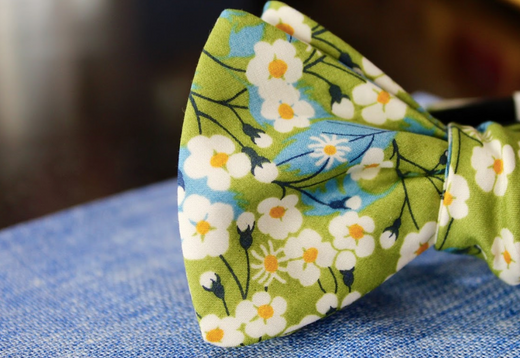The History of the Floral Bow Tie

Flowers have always been associated with the attributes of beauty and new life -- which is why many accessories - like the floral bow tie - are such successful adornments.
From peonies and poppies to daisies and roses, most flower fabrics carry their own fascinating history and symbolism. We explore how they helped the floral bow tie come into existence.
The Birth of Floral Fabric
Since the dawn of embroidery fashion in 12th Century China, floral fabrics were considered to be the utmost representation of wealth. In Asian culture, the incorporation of flowers in clothing was a distinct way to showcase privilege and luxury. One of the most common flowers seen in Chinese fabrics were peonies. These delicate blossoms were adored for their dynamic beauty and were said to symbolize good fortune.
With the expansion of trade to the West came the introduction of floral fabrics to continental Europe. Their complex nature and intricate designs attracted the nobles and affluent alike, and many of them ended up benefiting from the trade of these textiles. It was not until the 16th Century, when Italian weavers finally discovered how to produce these intricate fabrics for themselves.
Floral Fabric's Rise in Europe
Often, the designs of these botanically-themed textiles were directly inspired by colonial India where they had previously been imported from. Those floral fabrics had been known as "chintz". Made in a dizzying array of colors, they featured flowers that represented different elements of culture and history.
It wasn’t until the Industrial Revolution that floral textiles were available to everyone. As the weaving processes became faster and more efficient, fabric of all types, textures, patterns and colors became finally affordable to all.

The Introduction of Flowers to the Bow Tie
As the bow tie came into being in Croatia in the 16th Century, French soldiers brought the accessory back to their home country after the Thirty Year war. The new adornment was quickly adopted by upper-class men in French society, and as it was a time of of grand fashions focused on floral desigs under King Louis 14th, the floral bow tie was born.
How a Modern Man Can Dazzle with a Flower Bow Tie
These days, an excellent way to showcase your animated and charismatic personality is with a floral bow tie. Much like the historical fabrics, many flower-clad bow ties feature intricate designs and expressive colors. While these accessories are often bright and playful, when styled correctly, a floral bow tie can also be quite sophisticated.
Men’s floral bow ties are an exceptional choice for a springtime social, a summer brunch, or celebratory events such as a spring wedding or prom. To add brilliant color to your traditional style, try pairing your floral bow tie with a white button down, or perhaps even a pink or yellow dress shirt.

Are you a floral fan? Check out our floral bow tie, floral necktie and Liberty London collections to add to your blossoming collection!

